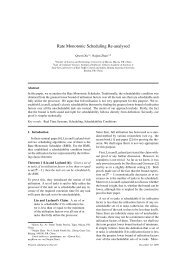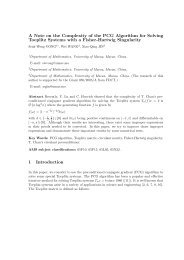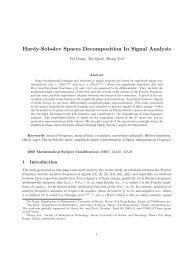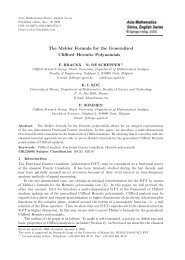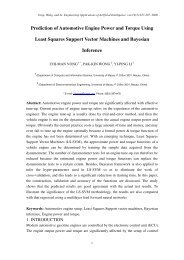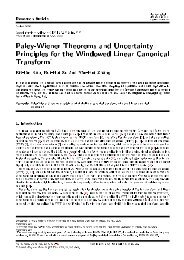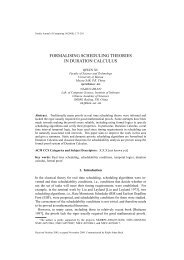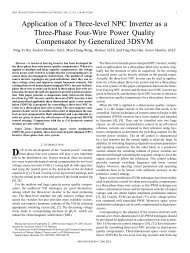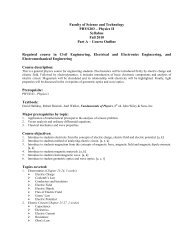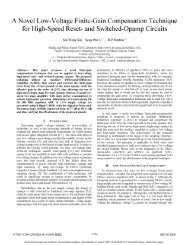Effect of pH on corrosion behavior of CuCrZr in solution without and ...
Effect of pH on corrosion behavior of CuCrZr in solution without and ...
Effect of pH on corrosion behavior of CuCrZr in solution without and ...
Create successful ePaper yourself
Turn your PDF publications into a flip-book with our unique Google optimized e-Paper software.
gradient is determ<strong>in</strong>ed by the electrode potential [15-17]. As the potential is further<br />
<strong>in</strong>creased, the anodic curves exhibit small peaks c<strong>on</strong>sistent with the formati<strong>on</strong> <str<strong>on</strong>g>of</str<strong>on</strong>g> a CuCl<br />
film [16, 17] at a potential <str<strong>on</strong>g>of</str<strong>on</strong>g> about -0.05 V. Bey<strong>on</strong>d the peaks, limit<strong>in</strong>g-current<br />
<strong>behavior</strong> is observed <strong>and</strong> the rate <str<strong>on</strong>g>of</str<strong>on</strong>g> anodic reacti<strong>on</strong> is c<strong>on</strong>trolled by the formati<strong>on</strong> <strong>and</strong><br />
dissoluti<strong>on</strong> <str<strong>on</strong>g>of</str<strong>on</strong>g> CuCl film [16]. The rate <str<strong>on</strong>g>of</str<strong>on</strong>g> the reacti<strong>on</strong> is probably driven by the cathodic<br />
reducti<strong>on</strong> <str<strong>on</strong>g>of</str<strong>on</strong>g> oxygen <strong>in</strong> neutral soluti<strong>on</strong>:<br />
O 2<br />
2H<br />
2<br />
O 4e<br />
4( OH )<br />
(7)<br />
In chloride soluti<strong>on</strong> at <str<strong>on</strong>g>pH</str<strong>on</strong>g> 7, the I corr <str<strong>on</strong>g>of</str<strong>on</strong>g> Cu <strong>and</strong> <strong>CuCrZr</strong> are the lowest (Fig. 11). It seems<br />
their polarizati<strong>on</strong> <strong>behavior</strong>s <strong>in</strong> chloride soluti<strong>on</strong>s are dom<strong>in</strong>ated by the dissoluti<strong>on</strong> <str<strong>on</strong>g>of</str<strong>on</strong>g><br />
copper to soluble cuprous chloride i<strong>on</strong> complex CuCl 2 - .<br />
For <strong>CuCrZr</strong> <strong>in</strong> soluti<strong>on</strong> <strong>without</strong> chloride at <str<strong>on</strong>g>pH</str<strong>on</strong>g> 10, passivati<strong>on</strong> is observed <strong>and</strong> the<br />
passive range (-0.1 to 0.25 V) is wider than that <str<strong>on</strong>g>of</str<strong>on</strong>g> <strong>CuCrZr</strong> at <str<strong>on</strong>g>pH</str<strong>on</strong>g> 7 <strong>and</strong> Cu at <str<strong>on</strong>g>pH</str<strong>on</strong>g> 10<br />
(Fig. 10). Their passive current densities are <str<strong>on</strong>g>of</str<strong>on</strong>g> the order <str<strong>on</strong>g>of</str<strong>on</strong>g> A/cm 2 . A th<strong>in</strong> <strong>and</strong> dense<br />
Cu 2 O layer formed <strong>on</strong> the surface <str<strong>on</strong>g>of</str<strong>on</strong>g> <strong>CuCrZr</strong> <strong>and</strong> Cu results <strong>in</strong> sp<strong>on</strong>taneous passivati<strong>on</strong>.<br />
Whereas, the polarizati<strong>on</strong> curves <str<strong>on</strong>g>of</str<strong>on</strong>g> <strong>CuCrZr</strong> <strong>and</strong> Cu show active <strong>behavior</strong> <strong>in</strong> choride<br />
soluti<strong>on</strong> at <str<strong>on</strong>g>pH</str<strong>on</strong>g> 10 <strong>and</strong> are similar to those at <str<strong>on</strong>g>pH</str<strong>on</strong>g> 7 (Fig. 11). The curves for <strong>CuCrZr</strong> <strong>and</strong><br />
Cu <strong>in</strong> 0.6 M NaCl start with similar active regi<strong>on</strong>s followed by active–passive transiti<strong>on</strong><br />
that occurs at comparable potentials. The sudden <strong>in</strong>crease <str<strong>on</strong>g>of</str<strong>on</strong>g> anodic currents at higher<br />
potentials is due to film breakdown, be<strong>in</strong>g accompanied by corrosi<strong>on</strong>.<br />
It has been shown that the potentiodynamic <strong>behavior</strong> <str<strong>on</strong>g>of</str<strong>on</strong>g> copper <strong>in</strong> slightly alkal<strong>in</strong>e<br />
soluti<strong>on</strong> exhibits anodic peak associated with the electro-formati<strong>on</strong> <str<strong>on</strong>g>of</str<strong>on</strong>g> Cu 2 O <strong>and</strong> CuO.<br />
Formati<strong>on</strong> <str<strong>on</strong>g>of</str<strong>on</strong>g> Cu 2 O occurs through:<br />
2Cu + H 2 O → Cu 2 O + 2H + + 2e - (9)<br />
10



